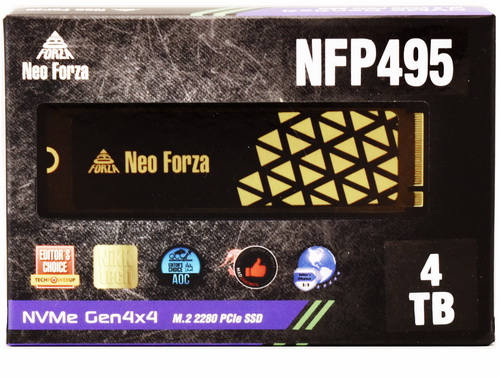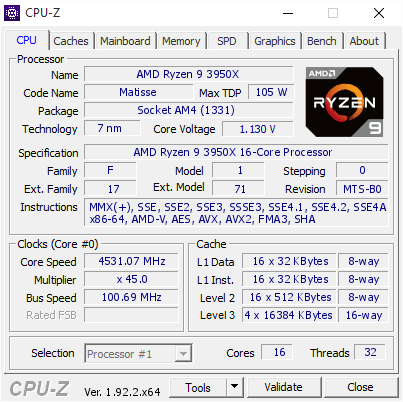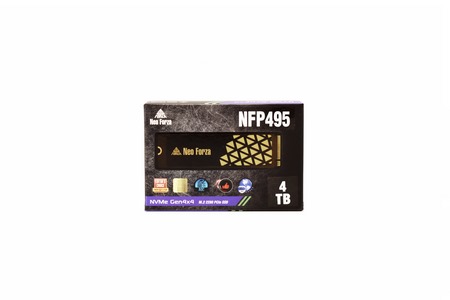INTRODUCTION

It's no secret that PCIe 5.0 Gen5 M.2 NVMe SSDs have been plagued with temperature issues (mostly on the NAND controller side) especially under heavy workloads since day one so it's no surprise that many SSD manufacturers are clearly reluctant to take that step. This instead means more PCIe 4.0 Gen4 models in the market and even though there are already countless such models the introduction of lower-cost DRAM-less NAND flash controllers means more affordable choices for non-demanding consumers. The latest NFP495 line of Gen4 M.2 NVMe SSDs by Neo Forza is based on one such controller and more specifically the MAP1602 by MaXio.
We are a professional team, studying in computer memory and storage devices industry for more than 10 years. In order to meet the rising demand on speed and capacity of the high-end gaming market players, we created Neo Forza, a new generation of ultra-standard overclocking module, SSD and other related storage device designing brand. Neo represents from virtual to reality, showing our core value for product innovation. Forza shows our strength and determination to meet gamers every need. Neo Forza possess strong resources, focus on core technology. From research & design, specific production to exceed the testing benchmark; Neo Forza keep pushing over technical boundary, providing top-notch performance and quality, providing gamers / game players extraordinary using experience.
The NFP495 line of PCIe 4.0 Gen4 M.2 SSDs currently contains 3 capacities (1/2/4TB) and as already mentioned features MaXio's DRAM-less MAP1602 12nm quad-channel (R5) NAND flash controller which once again is paired with 232-layer 3D TLC NAND flash by YMTC (X3 variant). The MAP1602 12nm quad-channel NAND controller by MaXio packs quite a few features including advanced wear leveling algorithms, Host Memory Buffer (HMB) architecture (uses a fraction of your PC's system memory to cache mapping tables), pseudo SLC cache, bad block management strategy, hardware error-correction, L1.2 ultra-low power state and sudden power-loss protection, TRIM, NCQ, hardware support for AES256/SM4 encryption and support for TCG OPAL2.0. In terms of warranty Neo Forza covers the entire NFP495 line with a 5-year limited one and as for durability they report a TBW (terabytes written) of 700 for the 1ΤΒ model, 1400 for the 2TB model and 2800 for the 4TB model.
SPECIFICATIONS AND FEATURES

THE NFP495 4TB
The NFP495 gets shipped inside the same box as previous models so at the front once again we find a product picture, the company logo and some media awards.
Warranty information and a 2D barcode pointing to the product page is what you’ll find at the rear.
On one side of the PCB Neo Forza has placed a black and yellow sticker with their name on it.
This is actually a thick sticker made out of copper so it should help with temperatures.


 Removing the sticker reveals the MaXio MAP1602 NAND flash controller and four 232-layer 3D TLC NAND flash modules.
Removing the sticker reveals the MaXio MAP1602 NAND flash controller and four 232-layer 3D TLC NAND flash modules.
Turning the SSD around we find yet another sticker which includes the serial and part numbers, barcode, country of manufacture and several certifications and warnings.
TEST BED


TESTING METHODOLOGY
Not long after I first started testing SSDs back in 2008, I concluded that it's almost impossible for any single benchmark suite to accurately measure their performance and that's why in certain benchmark suites we see amazing read/write performance numbers with some drives while in others things are quite different. The reason behind this is that some benchmarking suites are configured to read and write random chunks of data while others read and write constant (sequential) ones. So that's why i always use a very wide selection of benchmarking suites including AIDA64, HD Tach RW, HD Tune Pro, Crystal Disk Mark, Sisoftware Sandra Pro, AS SSD, IOmeter and ATTO. To get the most accurate results each test gets repeated a total of 6 times with the average performance numbers recorded into the charts*/****. Also, as of February 25th 2015 our results will also include the Storage Networking Industry Association’s (SNIA) IOMeter tests. These tests include a 12 Hour write test used to “simulate” performance degradation over time and a mixed workload test which basically shows what you can expect when using an SSD continuously for roughly two hours. Unfortunately, due to the time required for these tests they get repeated a total of 3 times and not 6 as the above.
Many people have made inquiries about our charts in the past so once again please do keep in mind that the Charts have the average performance numbers of each drive recorded and not the peak (highest) ones. Also, although every single one of these programs can help potential buyers choose the right drive for their needs you should also remember that from any kind of benchmark up to real world usage the gap is not small (and usually most differences will go unnoticed by most people). All tests were performed in a fresh Windows 10 Pro x64 installation complete with every update up to the date of this review.
* Since November 2018 the SSD comparison charts have been divided to 2.5” and M.2 models to reduce their growing size.
** Unless stated otherwise the Ryzen 9 3950x based Test Rig used for M.2 Gen 4 SSD reviews is not located in the lab.
*** As of January 2021 for Gen 3x4 models I’ll be using the Core i9-7980XE test rig (after numerous tests the up to 6% difference in read & write performance compared to the i7-6700 system simply wasn’t enough to justify having an extra test rig around).
**** Since February 2022 M.2 NVMe Gen3 and Gen4 SSD drives are placed in different charts.
TEST RESULTS - AIDA64 / ATTO


TEST RESULTS - HD TACH RW / HD TUNE PRO


TEST RESULTS - SISOFTWARE SANDRA PRO / CRYSTAL DISK MARK


TEST RESULTS - AS SSD / IOMETER


TEST RESULTS - IOMETER SNIA

CONCLUSION

The NFP495 M.2 Gen4 SSD by Neo Forza is a clear example of what happens when a NAND controller (or NAND flash) manufacturer can't deliver, either in terms of units or performance. This means that even though early NFP495 units reviewed by some of my colleagues used the TenaFE TC2201 NAND flash controller my sample came with the MaXio MAP1602A controller. Needless to say, the MAP1602 is a "safer" choice by Neo Forza since it's been used far more in other models but at the same time this means that i can't really vouch on what your NFP495 will come wearing (in all likelihood however it should be the MAP1602). That being said even though the MAP1602 is the better choice right now it doesn't impress with its performance, not in the NFP495 which is strange since the NM790 comes up on top in the majority of my tests. Since MaXio just like other NAND controller manufacturers customizes their firmware depending on the brand this difference in performance is probably due to firmware differences between the Neo Forza NFP495 and the Lexar NM790 (a bit may also be attributed to the difference in capacity).
With a price tag currently set at around USD180/185Euros the NFP495 4TB PCIe 4.0 Gen4 M.2 NVMe SSD by Neo Forza is priced exceptionally well. Yes, performance may not be great but the NFP495 more than makes up for that not only with its very affordable price tag but also its durability and 5-year warranty. This is exactly why I strongly recommend non-demanding users giving it a chance if they’re out in the market for a high-capacity Gen4 SSD, it might just surprise them.
PROS
- Overall Performance (For a DRAM Less Drive)
- Up To 4TB Capacity
- 5 Year Limited Warranty
- 2800TBW (Durability)
- Price (For Some)
CONS
- Thermal Throttling (During SNIA Tests)
- Performance (Compared To Similar Models)

 O-Sense
O-Sense
















